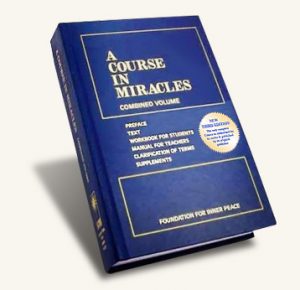Parallels between ACIM and Religious Science
A Course in Miracles is uniquely harmonious with the teachings of the Church of Religious Science who’s philosophy is known as Science of Mind. The fundamentals of both paths focus on the mind and our relationship with Spirit. Both take into account psychological aspects of our perceptions, how we engage and more importantly the resulting outcome. Both invoke the availability of a single Truth that is already a part of us and that we have a choice in recognizing the presence of Spirit within us, in every moment of our lives.
A Course in Miracles and Science of Mind are uniquely American. A Course in Miracles is based on a book by that name published in 1976. The material was “dictated” to Helen Schucman, a professor of medical psychology at Columbia University in New York beginning in 1965.
“The Science of Mind” originally published in 1922, was written by Ernest Holmes, the founder of the Church of Religious Science. His philosophy is based on writings by Henry David Thoreau, Ralph Waldo Emerson, Longfellow and William Wordsworth (British) but most greatly influenced by Emma Curtis Hopkins.
Both paths teach the ability to transcend the appearances of the world around us and see from a Spiritual point of view. The basic concept of Transcendentalism was popularized in the eastern United States in the early 1820s and 1830s. It is also influenced by Hindu texts. The core belief of Transcendentalism is in the inherent goodness of people and nature and that it is natural to express that goodness through our intuition.
A Course in Miracles and Science of Mind both teach that this intuition is actually the free expression of a loving God. A Course in Miracles places unique emphasis on Jesus Christ whereas the Church of Religious Science emphasizes the Bible and teachings of Jesus Christ but includes wisdom from many spiritual paths. It’s interesting to note that A Course in Miracles is often viewed as a path toward greater understanding of Christianity and Science of Mind aims to bring an understanding of Christianity together with the wisdom of other Spiritual paths. Both paths recognize our “One Source” and our relationship to it.
Communion with our Source is achieved through the absence of conscious thinking and in the stillness of Meditation. Essentially we can change the pattern of our thinking and our experience of life through Prayer, Meditation and Affirmation in both paths.
The lessons of A Course in Miracles encourage an ongoing openness to the expression of Spirit within our perceptions. Science of mind builds on the concept of our Oneness of Spirit by including a form of prayer known as “Treatment” which affirms that Oneness in the events of our daily lives. Both paths teach that the only way to lead a healthy Spiritual life is to recognize our Oneness. Meditation on the lessons in A Course in Miracles removes Ego based obstacles to the awareness of Oneness. Study, meditation and the form of prayer known as “Treatment” achieves the same goal in Science of Mind but with more emphasis on how it manifests in the physical world.
The Course provides a series of lessons in succession that result in seeing things objectively rather than subjectively. We are not taught what to think but instead how to see the world from Spiritual values based on Love and Communion with Source. Ideas are presented in a progressive manner that helps in recognizing and removing the man-made barriers to seeing the world with God's eyes. Thus we see anew, learning to understand, experience and express the relationship of Love and Forgiveness as opposed to our inner battle with Ego. Some individuals may choose to use another word instead of Ego but in the end, the goal is to see the world through the lens of Spirit. Both Science of Mind and A Course in Miracles place primary emphasis on choosing which lens we see the world through.
In the end, Science of Mind and A Course in Miracles teach harmony with an existing true nature. The love of God is an organic expression available to all us through seeking a deeper understanding of the Presence of Spirit within us.
Additional Comparisons
Science of Mind (SOM)
A Course in Miracles (ACIM)
SOM – Goodness and Spirit are already present and made accessible through our decision to see it. Faith in that truth visibly occurs through Affirmation and studies that provide a deeper understanding of our One Source and our choice to experience this presence.
ACIM – Goodness and Spirit are already present and made accessible by our choice to see it. Faith in that truth visibly occurs through meditation and seeming coincidences events and in our interactions with others.
SOM – The manifestation of Oneness can actually be seen. It is achieved through a greater understanding of “Law”; the dynamic energy of our One Source through study of philosophy, the Bible and meditation.
ACIM –The manifestation of Oneness can actually be seen. We learn to see it through the study and meditation on the lessons, which comprise A Course in Miracles.
SOM – Individual choice is a key element in on how to view things, based on a deeper understanding of various Spiritual teachings, primarily Christian. If we chose to see the expression of Spirit as it already exists, we will.
ACIM – Individual choice is a central concept in ACIM. The Holy Spirit helps us to see the expression of Spirit as it already exists merely by “a little willingness” to do so.


